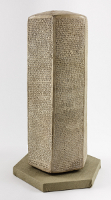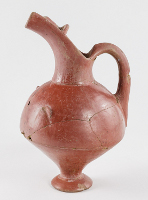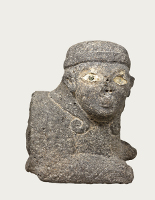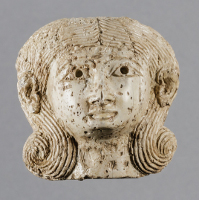The Dr. Norman Solhkhah Family Assyrian Empire Gallery features reliefs from the interior of the palace of King Sargon II at Khorsabad, including scenes of the king hunting by chariot, feasting, and the presentation of tribute. A highlight of the gallery is the Sennacherib Prism, a perfectly preserved record in cuneiform script of the reign of King Sennacherib of Assyria (ca. 704–681 BC), including his sack of Jerusalem, and a relief of Assyrian soldiers excavated at Tell Tayinat, Turkey.
The Henrietta Herbolsheimer, M.D. Syro-Anatolian Gallery presents material from Turkey, including rare monumental statuary and architectural elements from an Iron Age (ca. 800 BC) city, and examples of hieroglyphic Luwian script. The gallery also features the archaeology and cultures of the Amuq Valley from 6800 BC to the medieval era illustrated by lithics, pottery, seals, and jewelry. Anatolia was the source for much of the tin that fueled the Bronze Age, and the gallery features metallurgy and mining in Anatolia, including the oldest known bronze figurines (3400–2750 BC). Other highlights are Hittite pottery, Syro-Anatolian luxury goods (jewelry, libation bowls, and cosmetic containers), and a display on the development of the alphabet in Anatolia.
The Haas and Schwartz Megiddo Gallery features artifacts from the Oriental Institute’s excavations at Megiddo (ancient Armageddon), in Israel, including the famed Megiddo ivories, whose artistic style is evidence for early internationalism. The excavation of the mound at Megiddo is documented by objects such as lamps, weapons, and pottery arranged in stratigraphic order to illustrate how archaeologists could recreate the culture from 5000 to 600 BC. Other objects trace the rise of the Israelites and the royal city of Megiddo. Artifacts of special interest include a gold-covered statue of the Canaanite god El, a fragment of the Dead Sea Scrolls — one of few on permanent display in the United States — and a cast of the Moabite Stone.





